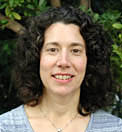Seismologist to discuss great earthquakes
and tsunamis on Wednesday, October 19
The December 2004 and March 2005 Sumatra earthquakes were the
two largest earthquakes to occur in the past 40 years. While
the human tragedy that accompanied these events is hard to comprehend,
the location of these earthquakes, at a subduction zone plate
boundary, is well known to generate the greatest earthquakes
and tsunamis worldwide. Susan Schwartz, professor of Earth sciences
and director of the Keck Seismological Laboratory, will explore
the tectonic environment of subduction zone faults in a talk
this week entitled "Great Earthquakes and Tsunamis: How,
Why, and Where?"

Susan Schwartz, professor of Earth
sciences, will discuss her research on earthquakes and
tsunamis.
|
Schwartz's talk, part of the Science
& Engineering Library's Synergy Lecture Series, will
take place at 4 p.m. on Wednesday, October 19, in the library's
Current Periodicals Room. Light refreshments will be available.
Schwartz will address questions of how and why great earthquakes
and tsunamis occur at subduction zone faults and what factors
control the mode and localization of strain release. Vast improvements
in the quantity and quality of both seismic and Global Positioning
System (GPS) data from subduction zones are allowing fault zones
to be imaged. These images reveal a patchwork of frictional
properties with a range of behaviors, from completely locked
patches that will fail in large earthquakes to zones with high
slip rates that are moving at the rate of the plate. Schwartz
will discuss results she has obtained from the Costa Rica seismogenic
zone and how that data adds to our overall knowledge of how,
why, and where earthquakes occur.
More information about the lecture series is available at the
S&E Library's
Synergy Lecture Series web site or by calling (831) 459-3141.
 Email this story
Email this story
 Printer-friendly version
Printer-friendly version
 Return to Front Page
Return to Front Page